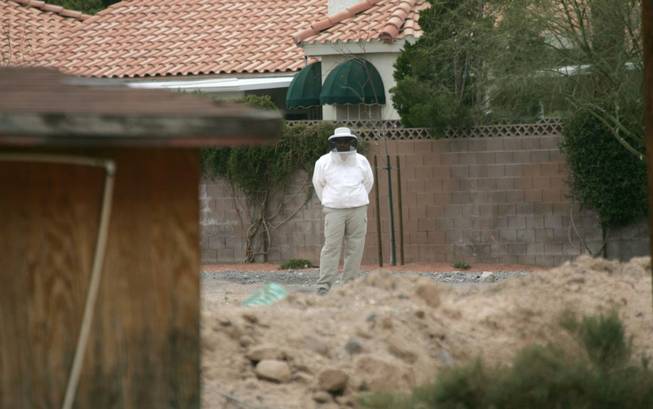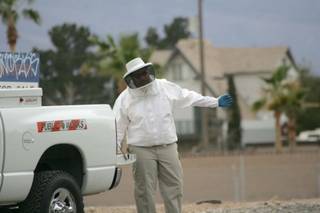
A beekeeper evaluates a site near Spencer Street and Eldorado Lane after a colony of Africanized bees was disturbed March 21.
Sunday, Sept. 28, 2014 | 2 a.m.
They’re known as killer bees, a moniker that works well for big-screen horror flicks but does an injustice to the insects that play a vital role in agriculture and have been fighting for their own survival in recent years.
Long before Africanized honey bees arrived in Nevada in 1997, their bad rap preceded them. The hybrids — bees from Africa that were bred with tamer European bees to improve their heat tolerance — escaped from a laboratory in Brazil in 1957 and began their inexorable march north.
It took them 33 years to reach Texas, where breathless TV reports told of hundreds, sometimes thousands, of bees swarming and stinging their victims — humans, horses, dogs, whatever might have agitated them. The bees invaded Arizona three years later. They made it to Nevada by 1998.
Now, Africanized bees have become so established in the Southwest that authorities no longer test bees after an attack a to determine whether they are European or Africanized.
What are they?
It’s impossible to differentiate with the naked eye Africanized honey bees and more placid European honey bees. They look virtually identical, and Africanized bee venom is no stronger. But Africanized bees are so hyperdefensive, they come across as super-aggressive. Startle their hive with a harsh sound or happen upon their hiding place, and the colony likely will target you with the stingers of hundreds of bees on suicide missions. Africanized bees tend to swarm more frequently and travel farther than other honey bees. They also employ more “guard” bees for hives and deploy in larger numbers when threatened.
Where do they live?
Among the places suitable for hives: utility boxes, irrigation control boxes, tires, lumber piles and sheds. Also, in crevices and holes in trees, walls or houses.
How to escape an attack
Run, while covering your face and head as best as possible. Seek shelter in a car or building. Do not jump into a pool, because the bees will hover until you come up for air. If you are stung, call 911 for possible hospitalization. Just one bee sting can kill a person who is allergic to a bee’s venom.
How to remove a bee hive
If you detect or suspect a hive on your property, don't call the fire department. Instead, call an exterminator (a list is provided by the Nevada Pest Control Association at (702) 385-5853), or a beekeeper who will try his best to relocate the hive to a safer location so they can continue their pollination mission. Among the beekeepers who do this: Bee Master of Las Vegas, (702) 457-6700; Beekeepers, (702) 832-4499; Rick Bilby, (702) 767-6607; and Torres Honey Bees, (702) 834-5333.
To thwart bees from homesteading on your property
❑ Caulk cracks in walls, foundation and roof.
❑ Fill or cover all holes 1/8-inch in diameter or larger in trees, structures and walls.
❑ Check where the chimney meets the house for separation, and make sure chimneys are capped properly.
❑ Put small-mesh screen (such as window screen) over rain spouts, attic vents, irrigation valve boxes and water meter box key holes.
❑ Remove trash and debris, such as tires, logs, drums or rock piles, that might serve as shelter for hives.
❑ Fill or cover animal burrows.
❑ Make sure window and sun screens fit tightly.
❑ Keep shed doors closed tightly. Exercise caution when entering buildings that aren’t used frequently.
❑ Inspect your home and yard regularly for signs of colonies. Look for large numbers of bees passing into, out of or hovering in front of openings. Listen for the hum of insects. Look for colonies in the ground, under eaves and in attics.
REPORTED BEE ATTACKS IN CLARK COUNTY, 2000 - 2014
Bee attacks aren’t recorded by Clark County, but they often make the news. Here is a list of bee attacks in Clark County since 2000, based on media reports. There may have been more.
February 2000: A 79-year-old man was stung by more than 30 bees while trying to remove a hive on a wood fence in the northwest valley.
March 2001: A 77-year-old woman survived being stung more than 500 times near Maryland Parkway and U.S. 95. The bees were attracted to something she was carrying in her bag.
May 2002: A hive was discovered in a tree about 100 feet from Kit Carson Elementary School at Alexander and D streets after at least three children were stung.
May 2003: An 88-year-old man was attacked after he applied Comet cleanser to a hive. The man said the bees had been in his front yard for years and efforts to rid them with bug spray had failed.
July 2003: Bees from a normally peaceful colony in Pahrump attacked three horses in a corral across the street, killing one. The beekeeper believed Africanized bees had taken over the hives.
October 2006: A 24-year-old man cleaning his truck in Sandy Valley was killed after hundreds of bees attacked him for unknown reasons.
March 2009: A 53-year-old man was stung hundreds of times by bees after he disturbed a nest while operating a backhoe in his son’s backyard near Spencer Street and Eldorado Drive.
June 2010: Strong winds split a tree at Oakey and Eastern avenues, exposing a large hive. Hundreds of agitated bees attacked people and animals in the neighborhood. Two people were hospitalized.
May 2012: A 69-year-old man was stung at least 300 times during a hike on Lone Mountain. He was taken by helicopter from the mountain to the hospital and survived the attack.
June 2014: A Las Vegas police dog was killed, and another hospitalized, after being stung at their handler’s home near Iron Mountain and Durango roads. The bees also stung the man.
— Rebecca Clifford-Cruz contributed to this report.


Join the Discussion:
Check this out for a full explanation of our conversion to the LiveFyre commenting system and instructions on how to sign up for an account.
Full comments policy